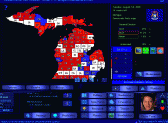After his controversial victory through a backroom deal with House Speaker Henry Clay when no candidate actually got a majority of Electoral Votes in the 1824 election, John Quincy Adams has had a rough presidential term, constantly fighting with a Congress dominated by supporters of his main rival, Andrew Jackson, and little has actually been accomplished. The once monolithic Democratic-Republican Party that dominated US politics as a one-party system since 1816 has been split now into the National Republican Party, built around President Adams and supported by Clay, which has come to resemble the now-defunct Federalist Party in doctrine and policy, and the Democratic Party, built around Jackson, a war hero who won a plurality of the Electoral Votes and popular vote in 1824, and feels the Adams-Clay deal robbed him of his rightful victory. Now the two bitter rivals from the previous election once again go head-to-head for the presidency.
Category: President Forever 2008 + Primaries
United States 1936
After his first term in office, Franklin D. Roosevelt has begun instituting his New Deal to combat the effects of the Great Depression. He is very popular with the working class, and has faced opposition from wealthy captains of industry and fiscal conservatives. The Republicans plan on mounting a challenge, but their frontrunner is much more a moderate. This scenario also allows the option of an alternate history, where Huey Long survives his assassination and mounts a challenge to Roosevelt, either as a challenger within the Democratic Party, or as a viable Third Party challenge with his Share Our Wealth Party, as it’s candidate or through a proxy candidate.
Indiana Senatorial 2010
Author: Rz9392
With Evan Bayh retiring, Republicans are poised to take back this senate seat. Can Democrats hold this seat in a traditonally red state?
Arizona Senatorial 2010
Author: Rz9392
With John McCain deciding to run for the U.S Senate again, after losing his Presidential bid against Barack Obama, the Republicans are poised to keep this seat. But with the recent surgence of the Tea Party, will J.D Hayworth score a victory and put this once certain pickup for the GOP into the tossup category?
Wisconsin Gubernatorial 2010
Author: Rz9392
With Democratic Governor Jim Doyle deciding not to seek reelection, the field is wide open. Will Republicans recapture the office with a surge of support nationwide? Or will Wisconsin stay blue?
Connecticut Senatorial 2010
With the announced retirement of long-term Connecticut Senator Chris Dodd, suffering from dropping showings in the polls due to a failed presidential bid, a move of residence to Iowa, and two scandals, the stage is open for a primary for both major parties with new faces. Who will become the new Class III Senator of the Constitution State?
Author: Patine
Michigan Election 2000
Author: Landon
Description: This Scenario is a simulation of the 2000 presidential election in the state of Michigan.
United States 1996
Bill Clinton has held office for four years and achieved record approval ratings, but the country is still in a recession and Clinton’s integrity is in question. Ross Perot has formed a new party with the intention of running again, as he did in ’92. Will the Republicans be able to put up a sizeable challenge to Clinton, or will Clinton win in a landslide as he did historically?
Author: Patine
Florida Senatorial 2010
With the retirement after one term of Republican Florida Senator Mel Martinez, and former Republican Governor Jeb Bush, who may have been allowed to run in the GOP primaries unopposed, decision not to run, sitting Governor Charlie Crist, who received the RNSC endorsement, and State House Speaker Marco Rubio, seemed the two most likely GOP candidates till, suffering low polls, Crist withdrew from the primary and is now running as an Independent. Also, a heated Democratic primary rages. Who will emerge victorious as Senator?
Author: Patine
Washington Senatorial 2010
Patty Murray faces a tough reelection bid for her fourth term in Washington’s Class III Senate seat, given a rising tide of Republican rhetoric and unpopular policies by President Obama. She is not only opposed within her own party, but by a gallery of Republicans. Who will win the Senate seat, a possible decider of the upper house’s majority in 2010.
Author: Patine


